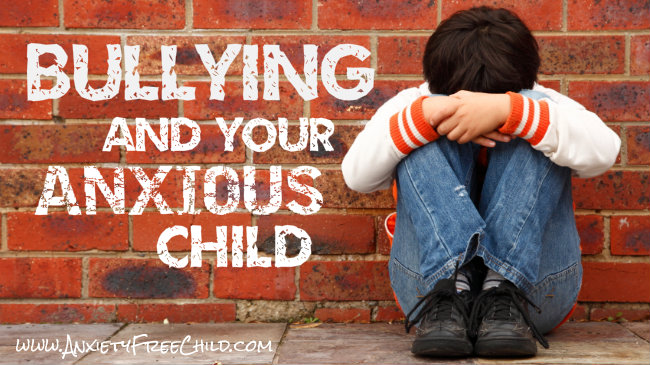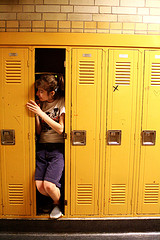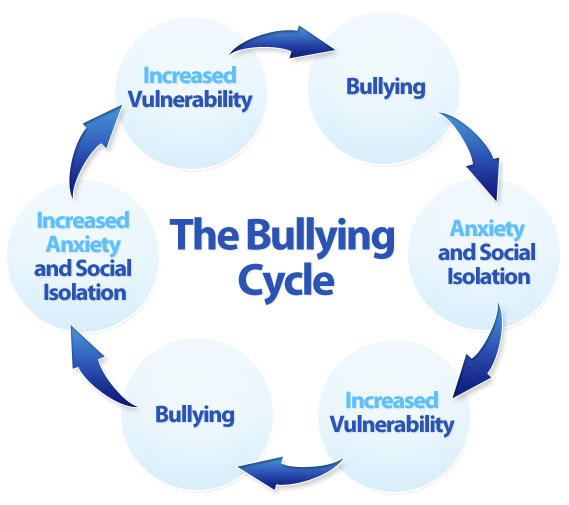 This post the first installment in our three-part series on bullying and your anxious child.
This post the first installment in our three-part series on bullying and your anxious child.
Bullying can kill. We’re not just saying this to scare you or your kid, but we want to let you know how severely detrimental or even deadly bullies can be. Even if it does not lead to death, it can contribute to a living hell for your anxious child, one fraught with physical injury, social distress and emotional scars that can last a lifetime.
Our three-part series examining bullying and your anxious child is aimed at helping you learn more about why and how it occurs, its forms and consequences, and how to deter or stop it when possible. Our three-part series consists of:
- Bullying and Your Anxious Child – offering a general overview of bullying in general
- School Bullying and Your Anxious Child – focusing on bullying in the classroom and in school
- Cyberbullying and Your Anxious Child – focusing on bullying online and over electronic devices
Our first order of business is to break the myth that bullying is normal behavior that should be tolerated as part of growing up. It certainly is not.
Breaking the Myth
The next time someone tries to feed you the clichés that “boys will be boys” or “girls that age are supposed to snotty,” don’t buy it. While an article in Pennsylvania’s The Lebanon Daily News distinctly reports that bullying or being bullied was once accepted by adults as a part of the developmental process, that is no longer the case.
Times have changed. Research and developments have been made. And the truth is that childhood bullying can be painful, harmful and create emotional repercussions that last well into adulthood, The Lebanon Daily News adds.
As you already learned, it can also be deadly.
Bullying contributes to 4,400 deaths per year, according to the Centers for Disease Control and Prevention. At least 14 percent of high school students have considered suicide due to bullying while 7 percent have actually attempted it. Yale School of Medicine reviewed studies out of 13 different countries and discovered an apparent link between being bullied and suicide.
It’s not only high school students who think suicide may be the sole means of escape. The American Association of Suicidology reports that suicide is and has been one of the leading causes of death in kids under the age of 14. The most recent available statistics, which the SSA says are from 2005, show that 270 kids ages 10 to 14 committed suicide. The SSA also says suicide rates among this age group have increased more than 50 percent over the past 30 years.
Bullying is a far cry from “kids just being kids.” It is instead an example of kids being victimized by any number of actions that fall into the broad category of bullying.
![]() Tweetable:
Tweetable:
Research has shown that bullying causes 4,400 deaths per year [tweet this]
What Bullying Is
 Another cliché that may still be kicking around is the thought of the bully as the big, beefy brute not unlike Popeye’s foe Bluto who physically beats up on his smaller and weaker prey. While that scenario is indeed a prime example of bullying, it is certainly not the only one.
Another cliché that may still be kicking around is the thought of the bully as the big, beefy brute not unlike Popeye’s foe Bluto who physically beats up on his smaller and weaker prey. While that scenario is indeed a prime example of bullying, it is certainly not the only one.
Bullying can be any “physical, verbal, or psychological attacks or intimidation against a defenseless person,” according to Cyberbullying.com, but it can also be any type of exertion of power meant to control or harm someone. This particularly applies if that someone has a tough time defending him or herself. Acting, speaking or writing things in an attempt to harm someone else all go into the bullying classification.
Thus the category bursts open to include hitting, kicking, tripping and hurling spitballs or random objects at the victim. It additionally includes verbal or written threats and intimidation, malicious taunting and teasing, and that age-old art known as name-calling. Stealing or wrecking someone’s belongings counts as bullying, as does making sexual remarks.
It can also be done in a more indirect manner, which is where the insidious bully tactic of spreading rumors fits in. Encouraging other people to exclude someone, reject someone or otherwise gang up against that someone are other painful and harmful forms of bullying.
Signs that Your Child is Being Bullied
Thankfully you don’t have to wait until your anxious child has reached the extreme level of despair to recognize signs that your child is being bullied. Leaving an open door of communication with your child is always a good way to find out, but not every kid may be willing or able to talk about it.
Children with anxiety may be embarrassed, ashamed or think the bullying would get worse if they’re stuck with the “tattletale” label. They may also suffer from low self-esteem and the false belief that the bullying is somehow their fault or that they deserve to be treated with such hatred and disdain.
Author Ted Zeff, who doubles as a counselor to sensitive children and adults, points out several signs that could mean your anxious child needs your help.
- Social isolation and disconnection
- Sleep issues, including frequent nightmares as well as difficulty falling or staying asleep
- Problems with concentration, decreased school performance
- Physical issues, such as stomachaches and headaches
- Loss of interest in things that used to be exciting, listlessness
- Hyper vigilance, being extremely nervous or emotionally explosive
If those signs sound strikingly similar to the symptoms of depression, that’s because they are. In fact, depression is one of the most common consequences of bullying on its victims.
Additional signs of depression noted by MayoClinic.com include:
- A change in eating habits
- Frustration over the smallest things
- Unexplained crying spells
- Feelings of worthlessness and guilt
- Self-blame when things go wrong
- Focusing on past failures
- Restlessness and agitation
- Frequent thoughts of dying, death or suicide
And then there’s the result of bullying that can perhaps hit your child in one of the areas where it hurts most: an increase in their anxiety.
As the parent of an child struggling with an anxiety disorder, you are probably already aware of the lineup of anxious symptoms which include rapid breathing, a rapid heart rate, trembling, sweating, fatigue and feelings of impending doom, apprehension and absolute powerlessness. Add a layer of bullying to existing anxiety and the symptoms can become even more frequent and severe. In fact, if you add a layer of bullying to any childhood experience the child can begin to develop anxiety issues or disorders where none formerly existed. If you feel your child’s anxiety is something you need help with, you may want to take a look at the material we offer here.
MayoClinic.com also notes childhood trauma does not always have an immediate effect but can result in anxiety disorders later in life. Panic attacks, post-traumatic stress disorder, OCD and social phobias are just a few of the disorders that can erupt from childhood trauma, and repeated bullying can very well count as that trauma.
![]() Tweetable:
Tweetable:
Learn the warning signs that your child may be being bullied and what to do [tweet this]
The Bullying Cycle and How It Relates to Anxious Kids
“While the experience of being bullied may cause or contribute to the development of anxiety disorders,” a report in Child Study Journal tells us, “it may also be the case that individuals experiencing heightened levels of anxiety may be more vulnerable to subsequent victimization.”
Because bullying can lead to an increase in anxiety symptoms, and due to the fact that anxious kids are more vulnerable to bullying to being with, the situation sets up a vicious cycle. This cycle continues to feed on and fuel itself ad infinitum. Thus once established, the bullying cycle can continue for years or even an entire childhood.
Meet the Bullying Cycle
- A child suffers from anxiety issues
- The bully chooses a victim based on perceived vulnerability, such as the child with anxiety issues
- The bully bullies, worsening the anxious child’s symptoms
- The anxious child may begin to act out or experience behavioral problems, unwittingly calling more attention to himself through his actions
- The bully fuels up on more ammo due to the anxious child’s worsening of symptoms and subsequent actions
- The bully bullies, worsening the anxious child’s symptoms
- The anxious child may begin to develop additional mental health issues and disorders, such as depression, which dig the anxious child into an even deeper and darker hole of anguish
- The bully notices the anxious child’s further descent into hell and stocks up on even more ammo for still more bullying attacks…

Is it any wonder the CDC reports 4,400 deaths each year are linked to bullying?
![]() Tweetable:
Tweetable:
Learn “The Bullying Cycle” and how it can effect your child [tweet this]
Anxious Children as the Victims
The bullying cycle’s relation to anxious children is not just anecdotal, either. A study published in Pediatrics and Adolescent Medicine showed bullying led to the development of depression and anxiety in children who were not suffering from either issue prior to the bullying.
The study looked at 1,116 sets of identical twins where one of the twins was subjected to bullying between ages 7 to 9 and the other twin had not been bullied. The subjects were culled from a range of economical and social classes throughout England and Wales and each set of twins shared the same family background and upbringing.
Examining twins from a range of economic and social backgrounds who shared the same family history helped eradicate the former theories that children’s mental health issues that appeared to stem from bullying had instead stemmed from poor or unstable environments.
The twin who experienced bullying was “significantly more likely” to show evidence of internalizing pain and problems by the time he or she reached 10 years of age, according to study author Dr. Louise Aresenault and her London King College colleagues.
Internalizing problems results in negativity being pushed and directed inward, where it preys on a child’s self esteem as well as mental and physical health. While directing negativity outward typically results in behavioral issues, directing negativity inward can instead result in anxiety, depression and the related symptoms such as stomachaches, fear of being left alone and continual crying jags. Inward-bound negativity can also manifest as extreme worry or guilt and becoming withdrawn.
“(The research) really supports the assumption or the belief that being bullied is bad for children’s health,” Arsenault said in Reuters Health. It’s bad for their health now and the scars can continue well into adulthood.
Another study, this one published in Pediatrics, had similar results. It showed victims of bullying had “significantly higher chances” of developing new mental health issues or worsening existing issues. It also went one step deeper to conclude that children with anxiety and depression had much greater chances of being victimized in the first place.
The study had 118 children aged 9 to 11 throughout elementary schools in the Netherlands complete a questionnaire. Follow-ups were conducted six months later. The study also stressed the need for health care professionals attempting to discern the reasons behind anxiety, depression and other mental health issues in children to keep bullying in mind as one of the potential causes.
Anxious Children as the Bullies
One more potential consequence of the bullying cycle is perhaps not as commonly discussed as the victim scenarios. That is the increased likelihood of children with certain mental health issues to become bullies themselves.
A study presented at the October 2012 American Academy of Pediatrics’ national conference in New Orleans uncovered evidence to back up the theory. Reports from parents of children with anxiety or children suffering from attention deficit hyperactive disorder disclosed that such children were three times more likely to be bullies. Additionally, children suffering from Oppositional Defiant Disorder, a condition marked by the desire for revenge and frequent tantrums, were six times more likely to be bullies.
Although the idea that anxious children tend to internalize their problems may seem to go against the idea that they would become bullies, one theory reported by the Huffington Post sheds some light on the issue. Because children with anxiety or depression may perceive situations as being more threatening or negative than they really are, they may lash out and become the very bully that so many others seek to avoid.
The data came the study analyzed came from the 2007 National Survey of Children’s Health, which looked at information from 64,000 parents of kids aged 6 to 17. Overall, about 15 percent of the children noted in the survey were identified as bullies.
That’s a heck of a lot of bullies. And it remains a heck of a problem.
This post is part 1 of 3 of our series, “Bullying and Your Anxious Child”. Click here to read part 2.
SOURCES:
- http://www.suicidology.org/home
- http://www.makebeatsnotbeatdowns.org/facts_new.html
- http://drtedzeff.com/news/warningsigns.php
- http://www.cdc.gov/ViolencePrevention/pdf/Bullying_Factsheet-a.pdf
- http://www.ncbi.nlm.nih.gov/pubmed/22909906
- http://www.mayoclinic.com/health/anxiety/DS01187/DSECTION
- http://www.education.com/reference/article/bullying-anxiety-what-connection
- http://www.reuters.com/article/2008/02/06/us-bullying-idUSCOL67503120080206
- http://www.huffingtonpost.com/2012/10/22/bullying-mental-health-problems_n_2001583.html
- http://www.ncbi.nlm.nih.gov/pubmed/22909906
- http://cyberbullyinghelp.com/tag/online-harrassment/
- Archives of Pediatrics and Adolescent Medicine, February 2008.
- Pediatrics, Vol. 117 No. 5 May 1, 2006, pp. 1568 -1574 (doi: 10.1542/peds.2005-0187)
- “Bullying.” The Lebanon Daily News (Pennsylvania). (August 25, 2006 Friday ): 866 words. LexisNexis Academic. Web.
- Olweus, D. (1978). Aggression in Schools: Bullies and Whipping Boys. Washington, DC: Hemisphere.
- Olweus, D. (2001). Peer Harassment: A Critical Analysis and Some Important Issues. In J. Juvonen & S. Graham (Eds.), Peer Harassment in School: The Plight of the Vulnerable and Victimized (pp. 3-20). New York: Guilford Press.
- Storch, E. A., Brassard, M. R., & Masia-Warner, C. L. (2003). The relationship of peer victimization to social anxiety and loneliness in adolescence. Child Study Journal, 33, 1-18.
- Photo Credits: emily_chiavelli





